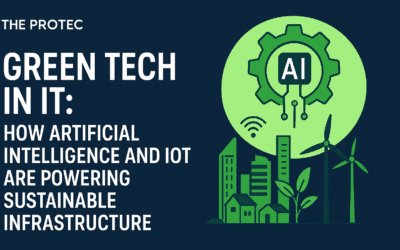The rapid ascent of Artificial Intelligence promises to revolutionize industries, from healthcare to logistics. But this powerful technology comes with a hidden, and growing, environmental cost. While we often focus on the computational marvels of large language models and image generators, we must also confront a critical question: what is the carbon footprint of model training? This post delves into the energy-intensive world of AI development, quantifying its environmental impact and providing a clear roadmap for practitioners to measure, manage, and mitigate it.
TL;DR
Training AI models, especially large ones, consumes vast amounts of energy, leading to a significant carbon footprint. Key factors include the model’s size, the hardware’s efficiency, the data center’s Power Usage Effectiveness (PUE), and the carbon intensity of the local electricity grid. By measuring energy use and applying carbon-aware strategies—like choosing efficient architectures, using cloud regions with cleaner energy, and carbon-aware scheduling—ML teams can drastically reduce their environmental impact without sacrificing performance.
Why the Carbon Footprint of Model Training Matters
As AI models grow exponentially larger—from millions to trillions of parameters—so does their appetite for computational power. This process, known as training, involves feeding massive datasets through complex algorithms to “teach” the model, a task that can run for weeks or even months on specialized, power-hungry hardware like GPUs and TPUs. The energy required for this is substantial, and when that energy comes from fossil fuels, it results in direct carbon dioxide emissions. A seminal 2019 study found that training a single large transformer model with neural architecture search can emit over 626,000 pounds of CO₂ equivalent—nearly five times the lifetime emissions of an average American car. Understanding and addressing this impact is no longer a niche concern but a core responsibility for the AI community.
Training vs. Inference: Where Does the Energy Go?
It’s crucial to distinguish between two phases of an AI model’s life:
- Training: The one-time (or periodic) process of creating the model. This is computationally intensive and concentrated, often happening in large data centers.
- Inference: The ongoing process of using the trained model to make predictions for end-users. While individual inferences are low-cost, the aggregate energy use can be massive for widely deployed models.
For many large-scale consumer applications, the cumulative energy of inference can eventually surpass that of training. However, the carbon footprint of model training remains a critical focal point because it is a direct, upfront cost of R&D, often involving extensive experimentation and hyperparameter tuning that can multiply the base energy cost many times over.
Quantifying the Impact: The Staggering Numbers
To grasp the scale of the problem, let’s look at some real-world examples. The training of OpenAI’s GPT-3, with 175 billion parameters, was estimated to have consumed 1,287 MWh of electricity—enough to power approximately 120 average U.S. homes for a year. Meanwhile, Google’s AlphaGo Zero project consumed megawatts of power during its training run.
The table below provides estimated examples for different model scales. Please note: These are illustrative estimates based on published research and can vary dramatically based on the factors discussed in the next section.
| Model Type / Example | Training Compute (PetaFLOPs-days) | Estimated Energy (kWh) | Estimated CO₂e (kg) |
|---|---|---|---|
| Small Model (e.g., BERT Base) | ~250 | ~400 | ~150 |
| Medium Transformer (e.g., T5-3B) | ~25,000 | ~40,000 | ~15,000 |
| Large LLM (e.g., GPT-3 scale) | ~3,640,000 | ~1,300,000 | ~500,000 |
Sources: Patterson et al. (2022), Strubell et al. (2019). Estimates assume a carbon intensity of ~0.385 kg CO₂e/kWh (U.S. average).
How to Measure the Carbon Footprint of Model Training
You can’t manage what you don’t measure. For ML teams serious about sustainability, establishing a carbon accounting practice is essential. Here is a step-by-step guide.
Step 1: Track Core Computational Resources
Start by logging the primary resources consumed during a training job. The most critical metric is GPU/TPU hours. Most cloud platforms and orchestration tools (like Kubernetes) provide this data. You’ll also need to know the specific hardware type (e.g., NVIDIA A100, V100) to find its typical power draw.
Step 2: Calculate Total Energy Consumption
Energy use is more than just the processors. You must account for the entire data center’s overhead using a metric called Power Usage Effectiveness (PUE). PUE is the ratio of total facility energy to IT equipment energy. A PUE of 1.0 is perfect, but the global average is around 1.59. Cloud providers often publish their PUE; for example, Google’s average Q4 2023 PUE was 1.10.
The Formula:
Total Energy (kWh) = (Number of Accelerators × Power Draw per Accelerator (kW) × Runtime (hours)) × PUE
Step 3: Factor in the Carbon Intensity of Electricity
The final step is to convert energy into carbon emissions. This depends entirely on the energy mix of the grid powering the data center. The carbon intensity measures grams of CO₂ equivalent emitted per kWh of electricity generated (gCO₂e/kWh). This varies wildly by region; for instance, a grid powered by coal can have a carbon intensity 10 times higher than one powered by hydro or nuclear. Resources like Electricity Maps provide real-time and historical data.
The Final Calculation:
CO₂e Emissions (kg) = Total Energy (kWh) × Carbon Intensity (kg CO₂e/kWh)
Worked Example: Measuring the Carbon Footprint of a Model Training Run
Let’s calculate the emissions for a hypothetical training job:
- Hardware: 8 NVIDIA A100 GPUs (rated at ~400W or 0.4 kW each under load).
- Runtime: 5 days (120 hours).
- Data Center PUE: 1.2 (an efficient cloud region).
- Carbon Intensity: 0.350 kg CO₂e/kWh (similar to the U.S. national average).
Step 1: Calculate GPU Energy
GPU Energy = 8 GPUs × 0.4 kW/GPU × 120 hours = 384 kWh
Step 2: Apply PUE for Total Energy
Total Energy = 384 kWh × 1.2 = 460.8 kWh
Step 3: Calculate CO₂e Emissions
CO₂e Emissions = 460.8 kWh × 0.350 kg CO₂e/kWh = 161.28 kg of CO₂e
This single training run emitted over 160 kg of CO₂e, equivalent to driving about 400 miles in a gasoline-powered car. Now, imagine repeating this process dozens of times for hyperparameter tuning.
Actionable Strategies to Reduce Your Carbon Footprint
Reducing emissions is a multi-faceted effort that aligns with cost savings and operational efficiency. Here are practical steps your team can take.
1. Algorithmic and Modeling Efficiency
- Choose Efficient Architectures: Opt for models designed for efficiency, like MobileNets for vision or newer, denser transformers that achieve more with less computation.
- Use Mixed Precision Training: Using 16-bit floating-point numbers instead of 32-bit can nearly halve training time and memory usage on supported hardware.
- Employ Transfer Learning and Distillation: Fine-tuning a pre-existing model is far less costly than training from scratch. Similarly, distilling a large “teacher” model into a smaller “student” model creates a deployable asset with a fraction of the inference cost.
2. Infrastructure and Operational Choices
- Select a Cloud Region with Low Carbon Intensity: This is one of the most impactful levers. Training a model in a region powered by wind or hydro (like Google’s Iowa region or AWS’s Oregon region) can cut emissions by over 80% compared to a coal-heavy region. Tools like Google Cloud’s Carbon Footprint and Azure’s Sustainability Calculator can inform this decision.
- Leverage Carbon-Aware Scheduling: Schedule training jobs to run when and where carbon-free energy is most abundant on the grid. This could mean training overnight or in a different geographic region based on real-time data.
- Use Preemptible or Spot Instances: These discounted compute options not only save money but can also reduce waste by utilizing otherwise idle capacity in data centers.
3. Process and Governance
- Train Once, Reuse Often: Avoid unnecessary retraining. Establish model registries and promote reuse across the organization.
- Optimize Hyperparameter Tuning: Use early stopping and more efficient search methods like Bayesian optimization to find optimal parameters with fewer training runs.
- Conduct “Carbon Reviews”: Make carbon impact a key metric in project reviews, alongside accuracy and latency.
Policy and Reporting Frameworks for Sustainable AI
For organizations, individual actions must be scaled through policy and transparent reporting. We recommend integrating the following into your sustainability and AI governance frameworks:
- Mandatory Carbon Accounting for Large Training Jobs: Any training job estimated to consume over a certain threshold of compute must include a carbon impact assessment in its proposal.
- Publish Key Metrics in Internal Reports: Track and report on:
- Total CO₂e from ML training per quarter.
- Average carbon intensity of compute used.
- Percentage of training done in carbon-aware modes.
- Adopt Emerging Standards: Follow the lead of frameworks like the CodeCarbon project, which provides a standard way to track emissions, and consider the Green Algorithms principles.
Frequently Asked Questions (FAQ)
Is inference a bigger problem than training for the carbon footprint of model training?
It depends on the scale of deployment. For a massively popular model like a flagship chatbot, the cumulative energy of billions of inferences will likely dwarf its one-time training cost. However, training is a concentrated, R&D-heavy activity where a single team’s decisions lock in a large portion of the model’s lifetime environmental impact. Both are critical to address.
Do cloud providers offset their emissions?
Many major cloud providers have committed to matching their electricity consumption with 100% renewable energy on an annual basis and have ambitious carbon neutrality goals. However, “matching” through Power Purchase Agreements (PPAs) is not the same as powering data centers with 24/7 carbon-free energy. There can still be times when a specific data center is drawing power from fossil fuels. It’s always best to check a provider’s specific sustainability reports.
Can’t we just plant trees to offset the emissions?
While carbon offsetting through reforestation or other projects has a role to play, it is not a primary solution. The tech industry’s mantra should be “efficiency first, then renewables, then offsets.” The most effective way to reduce emissions is to not create them in the first place by using energy more efficiently and sourcing it from carbon-free sources. Offsets should be used for residual, unavoidable emissions.
Are smaller models always greener?
Generally, yes. However, efficiency is about performance per watt. A well-designed, smaller model can often outperform a massive, inefficient one. The goal is to choose the smallest viable model architecture that meets your accuracy requirements.
What tools can I use to track this automatically?
Several open-source tools can help. CodeCarbon is a popular Python package that estimates emissions by tracking hardware and location. Cloud Carbon Footprint is a tool for visualizing cloud emissions across AWS, GCP, and Azure.
Conclusion: Towards a Greener AI Future
The environmental cost of AI is a significant and non-negotiable challenge. The carbon footprint of model training is a tangible metric that we, as an industry, must learn to measure, manage, and minimize. By embracing efficient algorithms, selecting sustainable infrastructure, and implementing carbon-aware policies, we can harness the power of AI without compromising the health of our planet. The journey to sustainable AI is not a solitary one; it requires a collective effort from researchers, engineers, and business leaders to prioritize our environment in every line of code and every training job we run.
Sources and References:
- Strubell, E., Ganesh, A., & McCallum, A. (2019). Energy and Policy Considerations for Deep Learning in NLP. – Source for the 626,000 lbs of CO₂e estimate for model training with NAS.
- Patterson, D., et al. (2022). Carbon Emissions and Large Neural Network Training. – Source for GPT-3 energy consumption (1,287 MWh) and methodology for carbon calculation.
- Uptime Institute Global Data Center Survey 2021. – Source for the global average PUE of 1.59.
- Google Data Center Best Practices 2023. – Source for Google’s Q4 2023 average PUE of 1.10.
- Electricity Maps. – Tool for real-time and historical data on grid carbon intensity.
- CodeCarbon Project. – Open-source tool for tracking emissions from compute.
- Google Cloud Carbon Footprint Documentation. – Example of a cloud provider’s carbon reporting tool.
- Azure’s Sustainability Calculator. – Microsoft Azure’s tool for estimating cloud emissions.
- NVIDIA Automatic Mixed Precision. – Source for information on mixed precision training benefits.
- Green Algorithms. – Principles and calculator for estimating computational project carbon footprint.
- Cloud Carbon Footprint Tool. – Tool for visualizing cloud emissions across multiple providers.
















